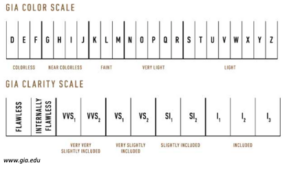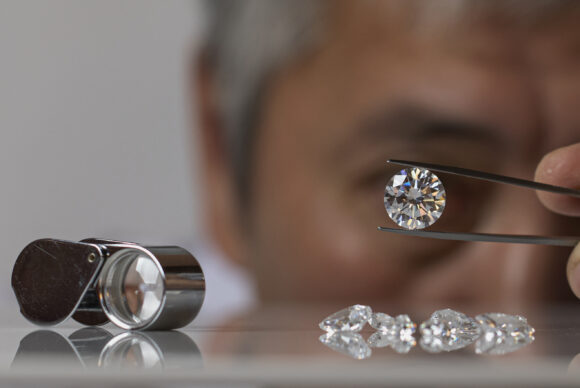Diamonds are one of the most coveted gemstones in the world. They symbolize love and commitment, embody strength, and have been represented in ancient and modern lore, poetry, and fiction. While every diamond is unique, there were no terms or factors for diamond quality until the 1940s, when the Gemological Institute of America (GIA) developed a grading system for color, clarity, and eventually cut. Along with carat weight, the “4Cs” of color, clarity, and cut became part of the diamond industry vernacular, and with the help of marketing by De Beers, became part of the language for consumers and jewelers alike.
4Cs and value
 Each of the 4Cs is important to determine the value of a diamond. Color is determined on a scale of colorless (D) to light yellow, brown, or gray (Z). Clarity is determined on a scale of Flawless, meaning no imperfections within or on the surface of the stone, to Included, the lowest being graded an I3. With each higher grade of diamond color or clarity, the overall per-carat value rises as well.
Each of the 4Cs is important to determine the value of a diamond. Color is determined on a scale of colorless (D) to light yellow, brown, or gray (Z). Clarity is determined on a scale of Flawless, meaning no imperfections within or on the surface of the stone, to Included, the lowest being graded an I3. With each higher grade of diamond color or clarity, the overall per-carat value rises as well.
Cut is the culmination of the overall look of the diamond: The fire and brilliance of the stone as well as the proportions of the gem. The scale for cut is assessed from Excellent, where the brilliance and proportions of the diamond are the best possible, to Poor. Carat weight is the unit of measurement for the physical weight of a diamond. The diamond trade refers to specific carat weight “magic sizes” where the overall price per carat rises, most notably at each half- and full-carat weight. A diamond weighing 0.99 carats does not look noticeably different from a diamond weighing 1.00 carat, but the price difference in per-carat weight rises substantially. When combined, the 4Cs represent the most important value drivers for a diamond.
While a diamond is the hardest mineral on earth, they can still occasionally break when hit in certain directions or become scratched or abraded due to normal wear and tear. If a diamond happens to become damaged in some way and needs to be recut or repolished to remove any chips, scratches, or abrasions, a stone can be sent to a master cutter. The master cutter will assess the damage, then recut or repolish the diamond to both remove the chips then repolish the entire stone as necessary in order to bring balance back to the proportions of the diamond. This is important to the stone, as you want the gem to look as good or better than prior to the damage, and not show any odd angles or off-center facets.
The situation
We received a claim for a damaged center diamond set within a high-end designer mounting. The original stone was a GIA certified round brilliant cut diamond weighing 2.73 carats exhibiting an F color and VS2 clarity. The chipped diamond had originally graded Excellent in cut.
Cracking the case
The diamond was sent to the high-end designer’s in-house master cutter. Through their assessment and eventual recutting and repolishing, the repaired diamond lost 0.30 carat of its total weight. This resulted in a final post-repair carat weight of 2.43 carats, which brought the gem down under the “magic” 2.50 carat size mark. However, the skill of the master cutter resulted in the diamond increasing in color to an E and clarity to a VS1 – each of these grades one higher than the original quality of the stone. While not often viable, the high skill of a master cutter can result in a better quality diamond. Usually, color or clarity is sacrificed to some degree in order to obtain a larger carat weight; When the master cutter repaired the diamond, they removed some imperfections which increased the grade of both the clarity as well as the color. In addition, the master cutter was able to maintain an Excellent grade for the cut.
The result
We were requested to determine the diminution of value based on the loss of carat weight from the original diamond (2.73 carat) to the repaired diamond (2.43 carat). While the diamond lost 0.30 carat, the increase in color and clarity for the finished diamond had a greater impact on the value of the resulting stone. Based on the diamond market at the time of our assessment, the diamond increased in value by $4,270. While it is unfortunate that the damage was initially sustained, recutting the damaged gem was the best thing that could have happened in terms of the diamond’s overall value.
Was this article valuable?
Here are more articles you may enjoy.


 ‘Door Knocker’ Roofers Were Everywhere. NC Farm Bureau Saw an Opportunity
‘Door Knocker’ Roofers Were Everywhere. NC Farm Bureau Saw an Opportunity  Instacart to Pay $60 Million in FTC Consumer Protection Case
Instacart to Pay $60 Million in FTC Consumer Protection Case  Rare Weather Warning Issued as Strong Gusts Fuel Colorado Wildfire Threats
Rare Weather Warning Issued as Strong Gusts Fuel Colorado Wildfire Threats  Insurance AI Demo Day Calendar Announced
Insurance AI Demo Day Calendar Announced 